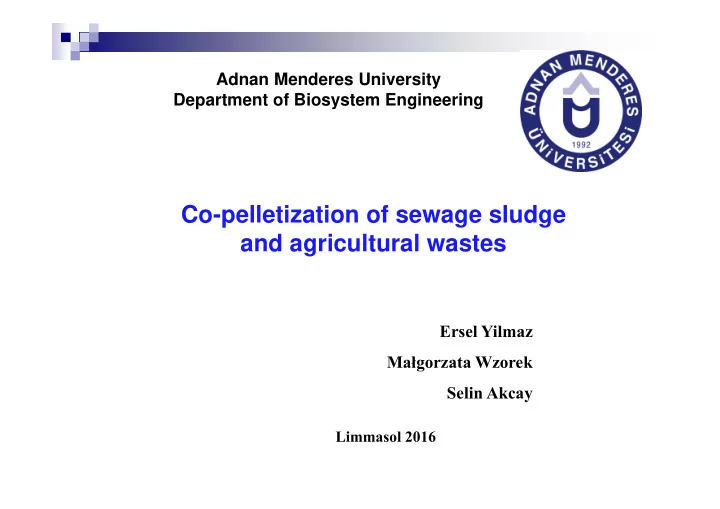

Adnan Menderes University Department of Biosystem Engineering Co-pelletization of sewage sludge and agricultural wastes Ersel Yilmaz Ma ł gorzata Wzorek Selin Akcay Limmasol 2016
Agricultural residues as a source of energy Turkey has great agricultural potential - 28.05 million ha arable land. Total amount of agricultural solid waste is about 50– 65 million tonnes. Cotton Olives Wheat
Characteristics of selected agricultural residues C H O N S As h Volatiles Type of Mois ture HHV % % % was te % MJ/kg d.m. d.m. d.m. Corncob 0 6.4 n.d. 45.53 6.15 41.11 0.78 0.13 17.81 Barley 15 4.9 n.d 46.8 5.53 41.9 0.41 0.06 18.79 straw Oat straw 15 4.9 n.d. 46 5.91 43.5 1.13 0.015 18.09 Wheat 7.75 6.22 15.68 46.95 5.355 1.05 0.51 0.22 18.5 straw Grape 7.5 67.9 50,0 6.0 34.4 2.0 0.1 22.1 waste Almond 1.2 79.3 49.2 6.0 43.4 0.2 0 19.7 shells Sunflower 40 3 52.9 6.58 35.9 1.38 0.15 20.82 straw Olive oil 7.1 77.3 48.9 6.2 36.2 1.4 0.2 21.6 waste
Animal waste Animal Was te Total dry Available LHV was te quantity manure dry manure MJ/kg tonnes /year tonnes /year tonnes /year Cattle 127,654,932 16,211,033 10,535,172 17.01 Sheep 24,558,323 6,139,581 758,146 11.08 Poultry 7,731,694 1,932,924 1,913,594 12.08
Production of wastewater in Turkey
5 Methods of treatment in WWTP in Turkey
Technical and technological aspects of the production of fuel from waste and biomass However, it is not always possible to use an already existing technology and the development of a new one requires solving a range of issues, some of which are as follows: • selection of fuel components which influence the properties, energy generation parameters in particular, including the selection of binding additives, • selection of a waste forming method, • adjustment of working parameters of the forming device so as to achieve the proper quality of the product.
Selected properties of components of pellets Parameter Unit Sewage Olive Animal Sludge Was te Was te (SS) (OW) (AW) Water % 85.00 65.00 90.97 HHV MJ/kg 11.22 18.79 8.85 Voltaire matter % d.m. 35.03 48.18 24.84 Ash % d.m. 41.02 22.02 9.52
Type of pellets In order to identify the pellets, individual symbols were attributed to them: SOW – pellets based on the sewage sludge and olive waste SAW – pellets obtained from the sewage sludge and animal waste The studies covered pellets with the sewage sludge content of 20% (SOW20, SAW20) and 30% (SOW30, SAW30) and pellets made of SS only.
Some parameters of pellets The research involved energy properties: • high calorific value (HHV) • the ash, the volatile matter content and moisture • the ultimate analysis and physical properties: • drop strength (according to the PN-G-04651), • water - resistance (PN-G-04652), • absorbance (PN-G-04652). 39
Forming device
The influence of the moisture content of the mixture being formed on the quality of fuel
Energy properties of pellets Hard coal Unit SOW20 SOW30 SAW20 SAW30 SS Parameter Water % 5.89 6.22 6.05 5.18 5.09 5.0-10.0 Voltaire % d.m. 30.17 29.73 30.78 29.67 37.88 25.0-40.0 matter Ash % d.m. 39.65 30.92 41.91 42.69 45.73 8.5-11.3 LHV MJ/kg 12.41 14.52 10.78 8.58 10.08 23.7-28.3 HHV MJ/kg 13.41 15.80 11.85 9.46 11.03 26.0-28.3 Elementary composition C 30.79 35.81 30.79 24.01 27.24 76.0-87.0 H 3.5-5.0 4.49 5.16 4.211 3.47 3.77 % d.m. N 1.54 1.38 1.8 1.71 2.11 0.8-1.5 S 0.55 0.79 1.98 0.94 1.97 0.5-3.1
Drop strength of pellets
Absorbability of pellets
Water-resistance of pellets (diameter 15 mm)
Conclusions • The developed technology of pellet production from residues consists in initially mixing sewage sludge with other waste in set proportions and then forming it into pellet and drying. • The processed and treated waste in the form of pellet allows for storing it without leading to secondary environment pollution and the assumed form of fuel facilitates transport, which increases potential for its use. • The tests for physical properties demonstrated that pellets may be subjected to mechanical handling operations which are connected with their transport, loading and unloading, etc. • However destructive effects of water on drop strength were observed for all test pellets. The fuels are characterised by high water absorbability and they should be protected against atmospheric precipitation for short-time intermediate storage.
Thank You for Your attention
Recommend
More recommend